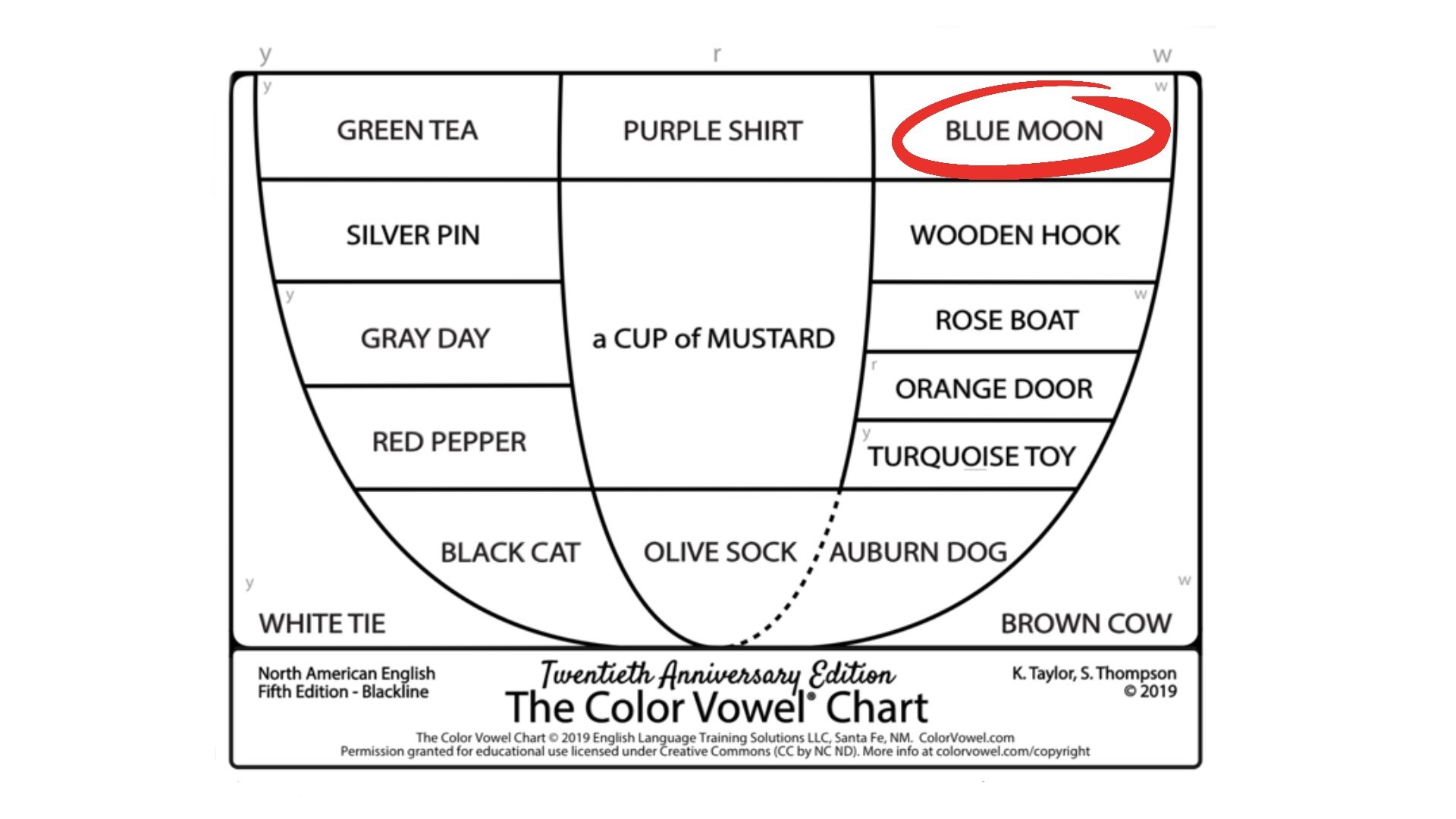The OO-Sound
We’re talking about the OO-sound now.
The OO-sound is represented by the letter u. This close back rounded vowel, or high back rounded vowel
The International Phonetic Alphabet (IPA) symbol for this sound is /u/. Its sound symbol is a regular ‘u’. Nothing special.
In General American English and Canadian English, the [u] sound is the sound in the word ‘BOOT’.
SYMBOL
On the IPA vowel chart, it is located on the top right of the chart.
The Color Vowel® Chart, created by Karen Taylor and Shirley Thompson in 1999, is another visual organizer for spoken English and represents how to learn and think about vowels. It refers to this sound as the ‘BLUE MOON’ sound or the BLUE vowel. Notice the consistent placement on the top-right corner of each respective chart.
The Color Vowel® Chart, 5th Edition © 2019. ColorVowel.com. Used with Creative Commons licensing (CC BY-NC-ND).
SOUND
The sound is sometimes referred to as a long U-sound.
The OO-sound typically comes in one of two forms.
A stand-alone OO-sound
A OO-sound preceded by a Y-sound [j]
For example, compare the following words.
FOO vs. FEW
FOO like in Foo Fighters is the stand-alone OO-sound.
FEW is the OO-preceded by a Y-sound.
In both cases, when you produce the OO-sound:
Start relaxed, then bring the corners of the lips towards the centre together so the lips round. The tongue tip stays forward, and the back part of the tongue lifts.
Focus on the movement from relaxed lips to rounded lips is important. This is part of the sound production process. The movement **into **the rounded lip position for the OO-sound is part of the quality of the sound.
FEATURES
The [u] sound features are as follows.
Its vowel height is close, also known as high, which means the tongue is positioned close to the roof of the mouth without creating a constriction that would be classified as a consonant. So, not enough constriction that it obstructs airflow like a stop, or fricative for example.
Its vowel backness is back, which means the tongue is positioned back in the mouth without creating a constriction that would be classified as a consonant.
Its roundedness is protruded, which means that the corners of the lips are drawn together, and the inner surfaces exposed. Imagine puckering your lips to give a kiss.
VISUAL REPRESENTATION
In English, the OO-sound is reflected in spelling in many different ways. Depending on the specific English dialect, it may be written using any of the following letters:
eu - sleuth, feud,
ew - blew, flew, dew, few, newt
o - do, to
oe - shoe, canoe
oo - too, zoo, moo, cool, woo, balloon, boot, choose, fool, goose, igloo, mood, moot, school, scoop, shoot, soon, swoop, tool, voodoo, zoom
ou - you, roux, soup,
ough - through
u - flute, cute, mule, music
ue - blue, rue, cue, rescue,
ui - juice, fruit
wo - two
The reason why I’m especially showing you the different spelling combinations that can create this sound is that there will ALWAYS be exceptions, weird spellings, or other things that impact how reliable the written representation will be.
I also want to be very clear that the OO-sound is NOT the same as the OO-letter combination. There are many words that are visually represented with a OO-letter combination that don’t have this sound.
Words pronounced with /ʊ/:
book, brook, cook, cookie, foot, good, hood, hook, look, rook, shook, stood, took, understood, whoosh, wood, wooden, wool,
Words pronounced with /ʌ/:
blood, flood
Words pronounced with /ɔː/:
floor, door, poor, moor,
pronounced with diphthong /əʊ/:
brooch
LISTENING
You need to be able to identify the sound; rhyming is an excellent way to match it properly. So, if you are not good already, start practicing rhyming and hearing the sound. If you want to practice listening, go back to the visual representation section and say those lists of words aloud. Pay attention to how they rhyme.
You can also refer to our growing list of minimal pairs below to see how we change one vowel sound to get each of the following.
| EE | IH | AY | EH | AA | UH | OO |
|---|---|---|---|---|---|---|
| bean |
bin | bane | Ben |
ban |
bun | boon |
| reed | rid | raid | red | rad | rud | rude |
| teak | tick | take | tech |
tack | tuck | toque |
*NOTE - The pronunciation for ‘toque’ is a Canadian English pronunciation.
I’m breaking down every single sound down for you so that you can learn how to produce each sound in English accurately. Sometimes, we’ll have easier sounds and sometimes we’ll have harder sounds.
If you’ve grasped this sound, then great! But if you’ve got a tip that might work for others, or you took a while to produce this sound correct but something clicked for you, let me know down below in the comments. My goal is to have a community know what to do when they’re stuck!



